#dxc technology
Explore tagged Tumblr posts
Text
DXC Progressing Minds Scholarship for Graduation Students in STEM 2024-25 Official Website:https://www.buddy4study.com/page/dxc-progressing-minds-scholarship
youtube
#obcrights#DXC#technology#students#education#studyabroad#university#college#scholarship#progressing#study#win#information#success#Youtube
0 notes
Text

HP hewlett packard
HP-branded corporations provide and operate technology that Israel uses to maintain its system of apartheid, occupation and settler colonialism over the Palestinian people. Hewlett Packard’s violations of Palestinian human rights have been well documented. Aside from providing services and technology to the Israeli army and police that maintain Israel’s illegal occupation and siege of Gaza, HP provides Israel’s Population and Immigration Authority with the exclusive Itanium servers for its Aviv System. This system enables the government to control and enforce its system of racial segregation and apartheid against Palestinian citizens of Israel, and is directly involved in Israel’s settler colonialism through its “Yesha database”, which compiles information on Israeli citizens in illegal settlements in the occupied Palestinian West Bank.
HP has been described as the “Polaroid of our times”, a reference to huge mobilisations against the use of Polaroid technology by the South African apartheid regime for its racist passbook system. Polaroid’s 1977 withdrawal from South Africa marked a turning point in the international effort to end apartheid there.
HP-E is contracted by Israel’s Population and Immigration Authority to provide and maintain the Itanium servers that house Israel’s population registry through 2020. Known as the Aviv System, this population registry is the basis of Israel’s ID card system. This ID system forms a core part of the Israeli apartheid regime’s tiered system of citizenship and residency that privileges Israel’s Jewish population and gives inferior status and rights to Palestinians, especially those in East Jerusalem. This leads to institutionalised racial discrimination and segregation in freedom of movement, housing, employment, marriage, healthcare, education, and policing. This discrimination is further exacerbated in the case of Palestinian “residents” in occupied East Jerusalem, whose most basic rights can and are being revoked arbitrarily.
The system also holds information about Israeli citizens living in illegal settlements in the occupied West Bank, therefore serving Israel’s settler colonial project directly. HP-E’s spin-off DXC Technology runs an R&D facility in the illegal settlement of Beitar Illit.
In 2015, HP split into HP Inc.- which carried on the brand name and provides consumer hardware, and HP-E for business and government services. In such a scenario, the BDS National Committee maintains that: “The onus is on each company to demonstrate to the public that it is free of illegal and unethical business activities.” Further, despite multiple requests for clarification, both the new companies sharing and profiting from the HP brand are yet to provide unambiguous evidence to show that their business activities with Israel do not violate International Humanitarian Law and Palestinian Human Rights. HP has, in the past, held a contract with the Israeli Ministry of Defence under which it developed and maintained the Basel System- the biometric identification system installed on checkpoints in the occupied Palestinian Territory, controlling the mobility of Palestinians. It also worked with the Israeli military, helping build its IT infrastructure. This included a program with the Israeli Navy which enforces the illegal naval blockade on Gaza. For these and other past ties of complicity with Israel’s occupation, apartheid and settler-colonialism, HP-branded companies must provide reparations to the Palestinian victims of these crimes.
https://bdsmovement.net/boycott-hp#tab3
38 notes
·
View notes
Text
2024 team sponsors recap!
this is completely irrelevant to F1 but i study and do these stuffs for a living sooo 😩😩 2023 sponsors are based on the sponsors that are there at the beginning of the season (new sponsors that join in the middle of the season will be classified as 2024's)
Mercedes AMG Petronas F1 Team:
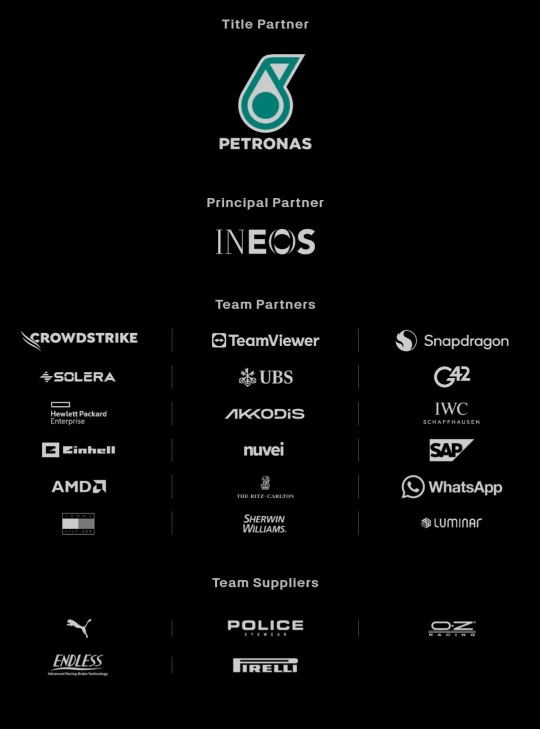
New sponsors: Whatsapp, Luminar (American tech company), SAP (German software company), nuvei (Canadian credit card services), Sherwin Williams (American painting company) 2024 data last update: 2024/02/14
Old sponsors that left: Monster Energy, Pure Storage (American technology company), fastly (American cloud computing services), Axalta (American painting company), Eight sleep (American mattresses company) 2023 data last update: 2023/01/07
Oracle Red Bull Racing F1 Team:
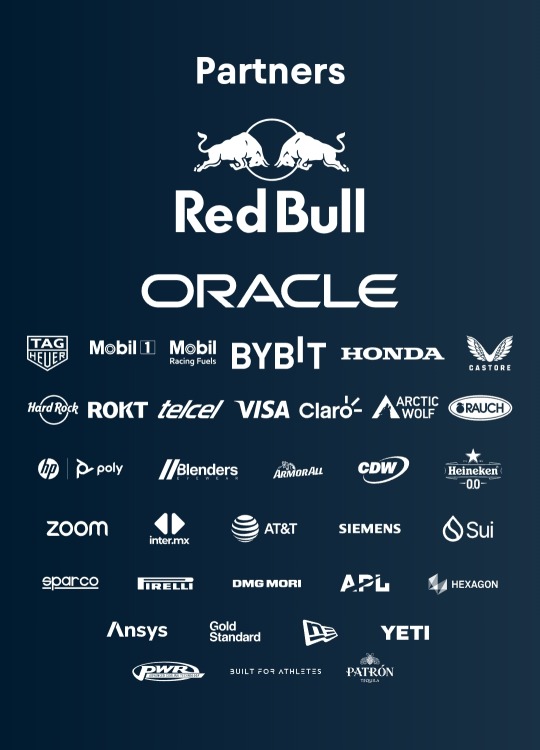
New sponsors: Yeti (American cooler manufacturer, joined later in 2023), APL (American footwear/athletic apparel manufacturer, joined later in 2023), CDW (American IT company, joined later in 2023), Sui (American tech app by Mysten Labs, joined later in 2023), Patron Tequila (Mexican alcoholic beverages company, joined later in 2023) 2024 data last update: 2024/02/15
Old sponsors that left: CashApp, Walmart, Therabody (American wellness technology company), Ocean Bottle (Norwegian reusable bottle manufacturer), PokerStars (Costa Rican gambling site), Alpha Tauri (? no info if they're official partners or not but Austrian clothing company made by Red Bull), BMC (Switzerland bicycle/cycling manufacturer), Esso (American fuel company, subsidiary of ExxonMobil), Hewlett Packard Enterprise (American technology company) 2023 data last update: 2023/03/07
More: Esso is a subsidiary of Mobil so there's possibility they merged or something
Scuderia Ferrari:
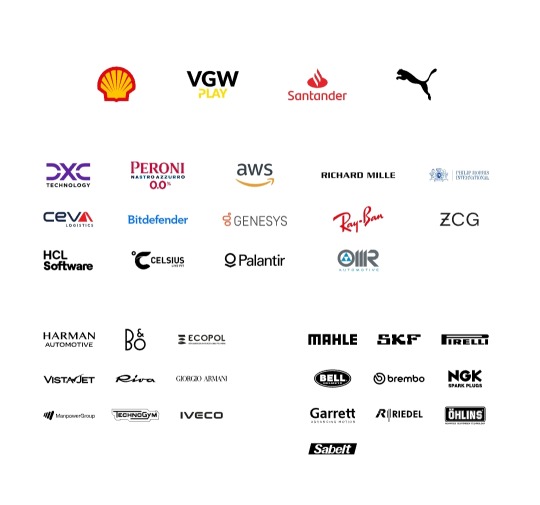
New sponsors: VGW Play (Australian tech game company, joined later in 2023), DXC Technology (American IT company, joined later in 2023), Peroni (Italian brewing company), Z Capital Group/ZCG (American private asset management/merchant bank company), Celsius (Swedish energy drink manufacturer) 2024 data last update: 2024/02/15
Old sponsors that left: Mission Winnow (American content lab by Phillip Morris International aka Marlboro), Estrella Garcia (Spanish alcoholic beverages manufacturer), Frecciarossa (Italian high speed train company) 2023 data last update: 2023/02/16
More: Mission Winnow is a part of Phillip Morris International. They are no longer listed as team sponsor but PMI is listed instead.
(starting here, 2023 data last update is 2023/02/23 and 2024 data last update is 2024/02/15)
McLaren F1 Team: (Only McLaren RACING's data is available idk if some of these are XE/FE team partners but anw..)
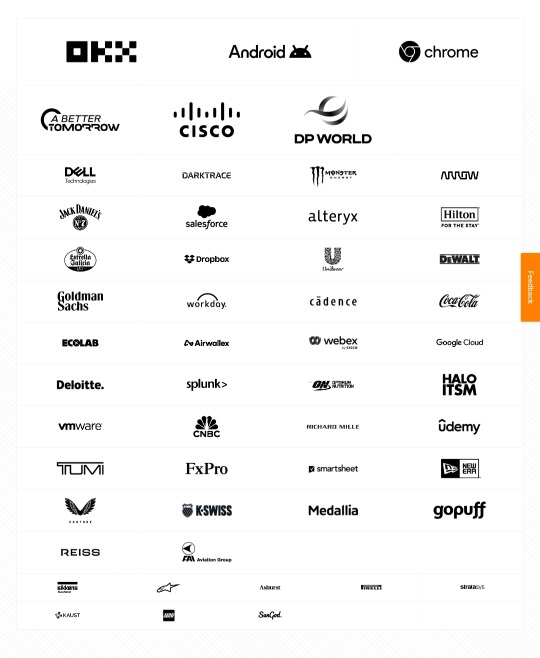
New sponsors: Monster Energy, Salesforce (American cloud based software company, joined later in 2023), Estrella Garcia (Spanish alcoholic beverages manufacturer), Dropbox (American file hosting company), Workday (American system software company, joined later in 2023), Ecolab (American water purification/hygiene company), Airwallex (Australian financial tech company), Optimum Nutrition (American nutritional supplement manufacturer), Halo ITSM (American software company, joined later in 2023), Udemy (American educational tech company, joined later in 2023), New Era (American cap manufacturer, joined in 2023), K-Swiss (American shoes manufacturer, joined later in 2023), Alpinestars (Italian motorsports safety equipment manufacturer)
Old sponsors that left: DP World (Emirati logistics company), EasyPost (American shipping API company), Immersive Labs (UK cybersecurity training company?), Logitech, Mind (UK mental health charity), PartyCasino (UK? online casino site), PartyPoker (American? gambling site), Sparco (Italian auto part & accessory manufacturer), Tezos (Switzerland crypto company)
Aston Martin Aramco F1 Team:
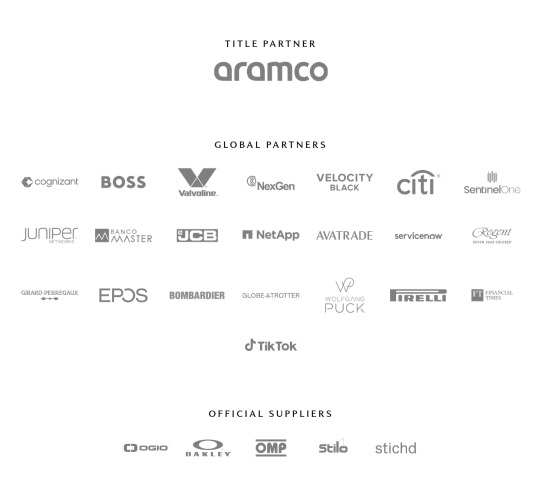
New sponsors: Valvoline (American retail automotives service company, joined later in 2023), NexGen (Canadian sustainable? fuel company), Banco Master (Brazilian digital banking platform, joined later in 2023), ServiceNow (American software company, joined later in 2023), Regent Seven Seas Cruise, Wolfgang Puck (Austrian-American chef and restaurant owner, joined later in 2023), Financial Times (British business newspaper), OMP (Italian racing safety equipment manufacturer), stichd (Netherlands fashion & apparel manufacturer)
Old sponsors that left: Alpinestars (Italian motorsports safety equipment manufacturer), crypto.com (Singaporean cryptocurrency company), ebb3 (UK? software company), Pelmark (UK fashion and apparel manufacturer), Peroni (Italian brewing company), Porto Seguro (Brazilian insurance company), Socios (Malta's blockchain-based platform), XP (Brazilian investment company)
Stake F1 Team (prev. Alfa Romeo):
???? Can't found their website (might be geoblocked in my country???)
BWT Alpine F1 Team:
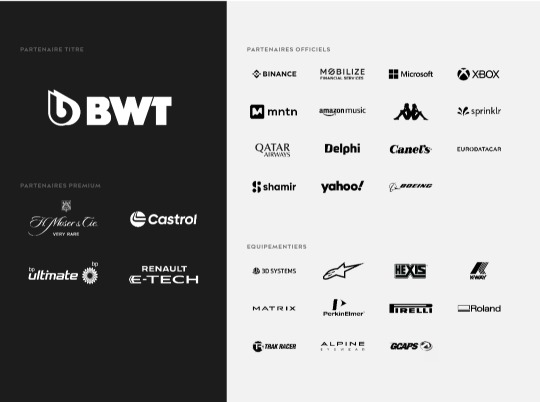
New sponsors: MNTN (American software company), H. Moser & Cie (Switzerland watch manufacturer), Amazon Music
Old sponsors that left: Bell & Ross (French watch company), Ecowatt (??? afaik French less-energy smthn smthn company), Elysium (French? American? Software company), KX (UK software company), Plug (American electrical equipment manufacturing company)
Visa CashApp RB F1 Team (prev. Scuderia Alpha Tauri):
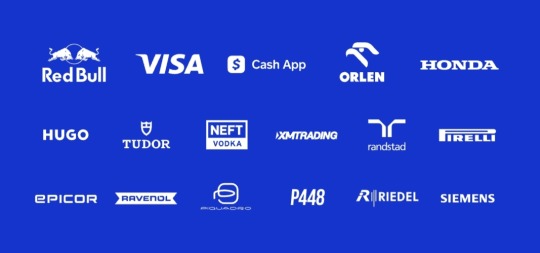
New Sponsors: Visa, CashApp, Hugo Boss, Tudor, Neft Vodka (Austrian alcoholic beverages company), Piquadro (Italian luxury bag manufacturer)
Old sponsors that left: Buzz (?), Carl Friedrik (UK travel goods manufacturer), Flex Box (Hongkong? shipping containers manufacturer), GMG (Emirati global wellbeing company), RapidAPI (American API company)
Haas F1 Team:
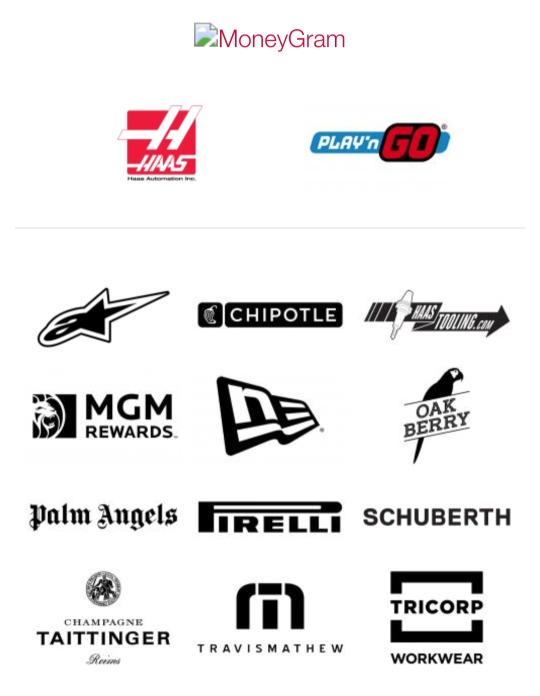
New sponsors: New Era (American cap manufacturer, joined later in 2023)
Old sponsors that left: Hantec Markets (Hongkong capital markets company), OpenSea (American NFT/Crypto company)
Williams Racing:

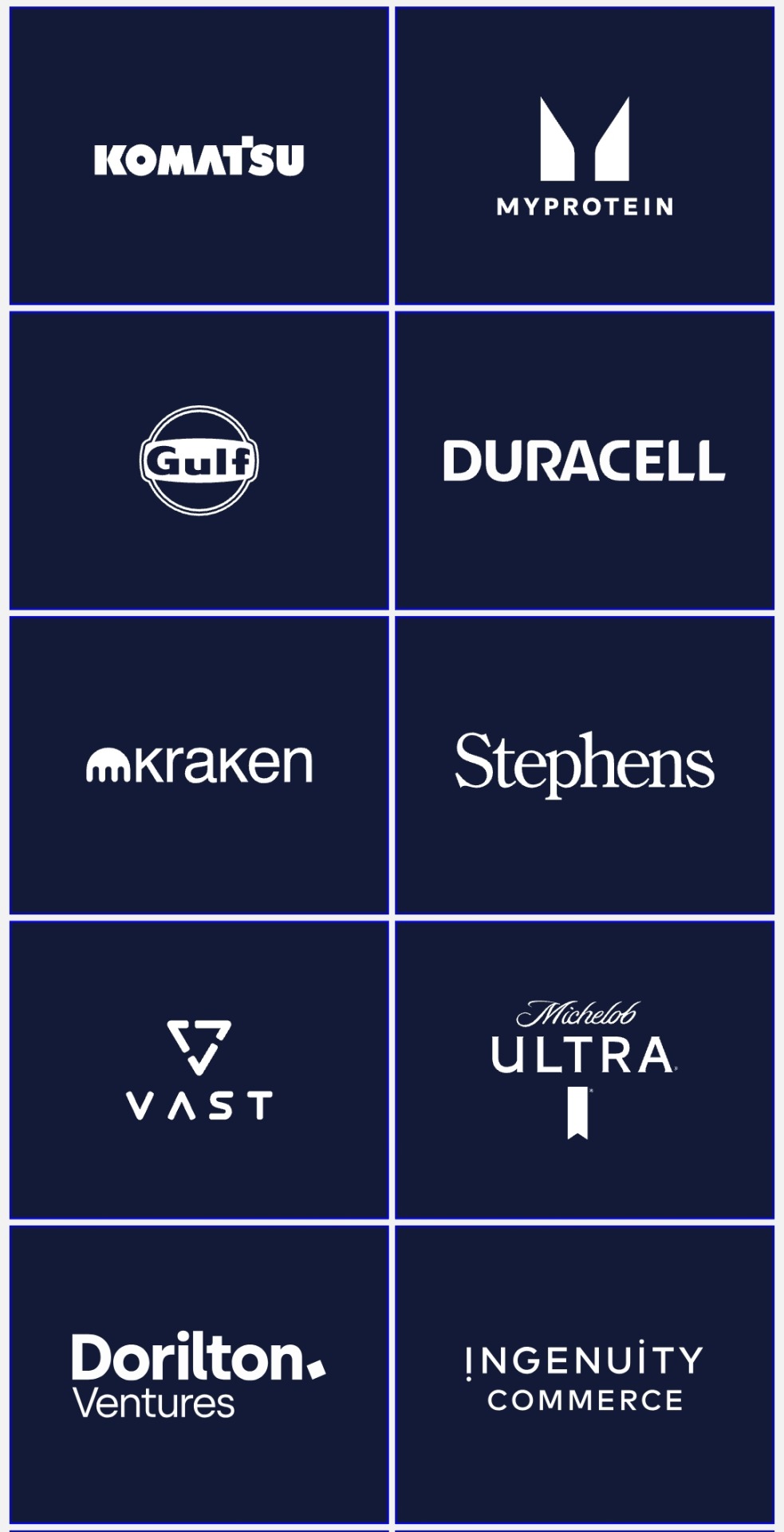
New sponsors: Komatsu, MyProtein (British bodybuilding supplement), Kraken (American crypto company, joined later in 2023), VAST Data (American tech company), Ingenuity Commerce (UK e-commerce platform), Puma (joined later in 2023)
Old sponsors that left: Acronis (Swiss software company), Bremont (British watch manufacturer), Dtex Systems (American? cybersecurity company), Financial Times (British business newspaper), Jumeirah Hotels & Resorts, KX (UK software company), OMP (Italian racing safety equipment manufacturer), PPG (American painting manufacturer), Umbro (English sports equipment manufacturer), Zeiss (German opticals/optometrics manufacturing company)
#mercedes amg petronas#red bull racing#scuderia ferrari#visa cash app rb#haas f1 team#mclaren f1#aston martin#alpine f1#williams racing#stake f1 team#f1#ari's rant#sponsor talks
42 notes
·
View notes
Text
Rail Asset Management Market Companies: Growth, Share, Value, Size, and Insights , Industry Overview and Forecast to 2031
Rail Asset Management Market Size And Forecast by 2031
The global Rail Asset Management Market study offers a thorough examination of the industry, highlighting the influence of leading companies on market dynamics and growth. These key players set the benchmark for innovation and operational excellence, contributing significantly to the development of the market. The study delves into their strategic initiatives, offering insights into how they navigate challenges and capitalize on opportunities. By focusing on these companies, the report paints a vivid picture of the competitive environment and its evolution.
The global rail asset management market size was valued at USD 11.54 billion in 2023 and is projected to reach USD 19.68 billion by 2031, with a CAGR of 6.90% during the forecast period of 2024 to 2031.
Get a Sample PDF of Report - https://www.databridgemarketresearch.com/request-a-sample/?dbmr=global-rail-asset-management-market
Nucleus is a secure, cloud-based platform designed to streamline data transfer and management for businesses. Its intuitive interface offers practice administrators and financial managers advanced filtering options, enhancing operational efficiency. By integrating various data sources, Nucleus enables effective prioritization of critical exposures, incorporating business context and threat intelligence to bolster security measures. Additionally, Nucleus supports seamless collaboration among multiple users across different applications, fostering rapid iteration and teamwork. Its deployment flexibility allows installation on-premises or via preferred cloud service providers, ensuring scalability and adaptability to meet diverse organizational needs.
Get More Detail: https://www.databridgemarketresearch.com/nucleus/global-rail-asset-management-market
Which are the top companies operating in the Rail Asset Management Market?
The Top 10 Companies in Rail Asset Management Market are known for their strong presence and innovative solutions. These include industry leaders. Each of these companies has made significant contributions through cutting-edge products, strategic partnerships, and global reach. Their ability to adapt to market trends and consumer demands has helped them maintain leadership positions in the market, driving growth and setting industry standards.
**Segments**
- Based on offering, the global rail asset management market can be segmented into solutions (asset performance management, condition-based maintenance, predictive maintenance, asset planning and scheduling, risk management, and others) and services (consulting, system integration, support and maintenance).
- On the basis of application, the market is categorized into rolling stock and infrastructure.
- In terms of deployment mode, the market can be divided into cloud-based and on-premises.
- Geographically, the market is segmented into North America, Europe, Asia-Pacific, South America, and the Middle East & Africa.
**Market Players**
- Some of the prominent players in the global rail asset management market are Siemens AG, GENERAL ELECTRIC, Hitachi, Ltd., IBM Corporation, Wabtec Corporation, Trimble Inc., L&T Technology Services Limited, Capgemini, Atkins Limited, and DXC Technology Company, among others. These companies are focusing on strategic collaborations, product enhancements, and geographic expansions to strengthen their market position.
The global rail asset management market is witnessing significant growth due to the increasing demand for optimized asset utilization, enhanced safety, and maintenance efficiency in the railway industry. Factors such as the growing need for cost-effective rail operations, regulatory requirements for safety compliance, and advancements in predictive maintenance technologies are driving the market growth. The adoption of rail asset management solutions and services is enabling railway companies to effectively manage their assets, improve operational performance, and reduce downtime.
The solutions segment, including asset performance management, condition-based maintenance, and predictive maintenance, is expected to dominate the market during the forecast period. These solutions help railway operators in monitoring and managing the health of their assets in real-time, predicting potential failures, and optimizing maintenance schedules. The services segment, particularly consulting and system integration services, is also witnessing significant demand as railway companies seek expert guidance in implementing asset management solutions.
North America and Europe are anticipated to hold a substantial market share in the global rail asset management market, attributed to the presenceThe global rail asset management market is experiencing robust growth driven by the increasing emphasis on optimizing asset utilization, enhancing safety standards, and improving maintenance efficiency within the railway industry. One of the key factors fueling this growth is the rising demand for cost-effective rail operations as companies look to streamline their processes and lower operational costs. Moreover, regulatory requirements for safety compliance are prompting railway operators to invest in advanced asset management solutions to ensure the well-being of passengers and employees.
Another significant driver of market growth is the rapid advancements in predictive maintenance technologies. By leveraging predictive maintenance solutions, railway companies can proactively identify potential issues with their assets, thereby minimizing unplanned downtime and optimizing maintenance schedules. This proactive approach not only improves operational efficiency but also enhances the overall reliability of railway operations.
In terms of market segmentation, the solutions segment, encompassing asset performance management, condition-based maintenance, and predictive maintenance, is expected to dominate the market landscape. These solutions offer railway operators real-time insights into the health of their assets, enabling them to make data-driven decisions and prioritize maintenance activities effectively. Furthermore, the services segment, especially consulting and system integration services, is witnessing increased demand as companies seek expert guidance in implementing complex asset management solutions tailored to their specific needs.
Geographically, North America and Europe are projected to hold significant market shares in the global rail asset management market. These regions boast mature railway infrastructures and robust regulatory frameworks, which drive the adoption of advanced asset management solutions. Additionally, the presence of key market players and ongoing investments in research and development activities further contribute to the market growth in these regions.
Moving forward, market players such as Siemens AG, GENERAL ELECTRIC, Hitachi, Ltd., and IBM Corporation are anticipated to continue focusing on strategic collaborations, product enhancements, and geographic expansions to strengthen their market presence. By developing innovative solutions that address the evolving needs of the railway industry, these companies are well-positioned to capitalize on the growing demand for rail asset management solutions and services globally.
Overall, the global rail asset**Market Players**
Siemens (Germany), IBM (U.S.), Hitachi (Japan), Wabtec (U.S.), SAP (Germany), Trimble (U.S.), Bentley Systems (U.S.), Bombardier (Canada), Atkins (U.K.), DXC Technology (U.S.), Trapeze (Canada), Tego (U.S.), Konux (Germany), L&T Technology Services Limited (India), Capgemini (France), Accenture (Ireland), Huawei Technologies (China), Cyient (India)
The global rail asset management market is undergoing substantial growth driven by various factors such as the increasing demand for optimized asset utilization, enhanced safety standards, and improved maintenance efficiency within the railway industry. One of the primary drivers behind this growth is the need for cost-effective rail operations as companies strive to streamline their processes and reduce operational expenses. Additionally, stringent regulatory requirements focusing on safety compliance are compelling railway operators to invest in advanced asset management solutions to ensure the well-being of passengers and employees.
Furthermore, the rapid advancements in predictive maintenance technologies are playing a significant role in shaping the market landscape. Predictive maintenance solutions empower railway companies to proactively identify potential asset issues, thus minimizing unplanned downtime and optimizing maintenance schedules. This proactive approach not only enhances operational efficiency but also boosts the overall reliability of railway operations.
In terms of market segmentation, the solutions segment, comprising asset performance management, condition-based maintenance, and predictive maintenance, is expected to maintain dominance in the market. These solutions provide
Explore Further Details about This Research Rail Asset Management Market Report https://www.databridgemarketresearch.com/reports/global-rail-asset-management-market
Key Insights from the Global Rail Asset Management Market :
Comprehensive Market Overview: The Rail Asset Management Market is growing rapidly, driven by technological advancements and evolving consumer preferences.
Industry Trends and Projections: The market is expected to grow at a CAGR of X% over the next five years, with increasing automation and digitalization.
Emerging Opportunities: New market segments, such as sustainable and eco-friendly solutions, are creating significant growth prospects.
Focus on R&D: Companies are investing heavily in R&D to innovate and improve product offerings, ensuring market leadership.
Leading Player Profiles: Major player dominate the market with strong portfolios and strategic partnerships.
Market Composition: The market is diverse, with a mix of large enterprises and emerging startups driving competition and innovation.
Revenue Growth: The market has witnessed a steady increase in revenue, primarily driven by growing demand and product diversification.
Commercial Opportunities: There are considerable opportunities for business expansion in emerging regions and through technological innovations.
Get More Reports:
Middle East and Africa Deep Learning Neural Networks (DNNs) Market Size, Share, and Trends Analysis Report – Industry Overview and Forecast to 2028 Middle East and Africa Radioimmunoassay Market Size, Share, and Trends Analysis Report – Industry Overview and Forecast to 2030 Japanese Encephalitis Market Size, Share, and Trends Analysis Report – Industry Overview and Forecast to 2029 Europe Pancreatic Cancer Diagnostics Market Size, Share, and Trends Analysis Report – Industry Overview and Forecast to 2030 Topical Antibiotics Market Size, Share, and Trends Analysis Report – Industry Overview and Forecast to 2029 Foundry Chemicals Market Size, Share, and Trends Analysis Report – Industry Overview and Forecast to 2031 Optical Character Recognition Market Size, Share, and Trends Analysis Report – Industry Overview and Forecast to 2029 Automotive Helicol Coil Spring Market Size, Share, and Trends Analysis Report – Industry Overview and Forecast to 2029 Portable Oxygen Concentrators Market Size, Share, and Trends Analysis Report – Industry Overview and Forecast to 2030 Asia-Pacific Treasury Software Market Size, Share, and Trends Analysis Report – Industry Overview and Forecast to 2030 Multi Cell Battery Market Size, Share, and Trends Analysis Report – Industry Overview and Forecast to 2028 Europe RF Over Fiber Market Size, Share, and Trends Analysis Report – Industry Overview and Forecast to 2029
Data Bridge Market Research:
Contact Us:
Data Bridge Market Research
US: +1 614 591 3140
UK: +44 845 154 9652
APAC: +653 1251 975
Email:- [email protected]"
0 notes
Video
youtube
"Ragul Raj's Journey: From Arich Infotech Training to DXC Technologies! 🚀
#youtube#training and placements#jobsearch#job#mainframe training#information technology#mainframe#Java Training#online jobs#it jobs#jobseekers#MicrosoftCloud#ibm#corporate training#training#javatraining#cloudcomputing#cloud transformation
0 notes
Text
Managed Services Market Analysis, Size, Share, Growth, Trends, and Forecasts by 2031

The Global Managed Services market is a dynamic sector within the broader technology industry that encompasses a wide array of services and solutions aimed at outsourcing the management of various IT functions and processes.
𝐆𝐞𝐭 𝐚 𝐅𝐫𝐞𝐞 𝐒𝐚𝐦𝐩𝐥𝐞 𝐑𝐞𝐩𝐨𝐫𝐭:https://www.metastatinsight.com/request-sample/2665
Top Companies
Accenture plc
Amazon Web Services, Inc.
Aryaka Networks, Inc.
AT&T Inc.
Atera Networks Ltd.
Atos SE
BMC Software, Inc.
Broadcom Inc.
Capgemini SE
Cisco Systems, Inc.
DXC Technology Company
Fujitsu Ltd.
HCL Technologies Limited
HP Development Company, L.P.
IBM Corporation
This industry is characterized by its multifaceted nature, catering to the diverse needs of businesses across different sectors worldwide.
𝐄𝐱𝐩𝐥𝐨𝐫𝐞 𝐭𝐡𝐞 𝐅𝐮𝐥𝐥 𝐑𝐞𝐩𝐨𝐫𝐭:@https://www.metastatinsight.com/report/managed-services-market/2665
The Global Managed Services market revolves around the provision of outsourced support and maintenance services for IT infrastructure, applications, and systems. This includes but is not limited to network monitoring, security management, data backup and recovery, cloud computing, and help desk support. Companies operating in this industry offer a comprehensive suite of services designed to offload the burden of IT management from their clients, allowing them to focus on their core business objectives.
The Global Managed Services market caters to a diverse range of industries, including but not limited to healthcare, finance, manufacturing, retail, and telecommunications. Each industry has its own unique set of challenges and requirements, necessitating customized managed services offerings to address specific needs and compliance regulations.
Moreover, the increasing adoption of managed services by small and medium-sized enterprises (SMEs) has significantly contributed to the growth of the market. SMEs often lack the internal IT capabilities and resources of larger organizations, making them prime candidates for outsourced IT management solutions. Managed service providers offer cost-effective and scalable services that allow SMEs to leverage enterprise-grade technology without the need for substantial upfront investments.
The Global Managed Services market is a dynamic and rapidly evolving sector within the technology industry, offering a wide range of outsourced IT management solutions to businesses worldwide. By addressing the growing complexity of IT environments, driving digital transformation initiatives, and catering to the diverse needs of industries and SMEs, managed service providers play a pivotal role in shaping the future of IT management.
Global Managed Services market is estimated to reach $707.0 Million by 2031; growing at a CAGR of 11.5% from 2024 to 2031.
Contact Us:
+1 214 613 5758
#ManagedServices#ManagedServicesmarket#ManagedServicesindustry#marketsize#marketgrowth#marketforecast#marketanalysis#marketdemand#marketreport#marketresearch
0 notes
Text
Associate Manager ERP Package Applications
Job Description:Why join DXC Technology? DXC Technology (NYSE: DXC) helps global companies run their mission-critical systems and operations while modernizing IT, optimizing data architectures, and ensuring security and scalability across public, private and hybrid clouds. The world’s largest companies and public sector organizations trust DXC to deploy services to drive new levels of…
0 notes
Text
Associate Manager ERP Package Applications
Job Description:Why join DXC Technology? DXC Technology (NYSE: DXC) helps global companies run their mission-critical systems and operations while modernizing IT, optimizing data architectures, and ensuring security and scalability across public, private and hybrid clouds. The world’s largest companies and public sector organizations trust DXC to deploy services to drive new levels of…
0 notes
Text
Smart Railways Market Trends, Share, Opportunities and Forecast By 2028
The Smart Railways Market sector is undergoing rapid transformation, with significant growth and innovations expected by 2028. In-depth market research offers a thorough analysis of market size, share, and emerging trends, providing essential insights into its expansion potential. The report explores market segmentation and definitions, emphasizing key components and growth drivers. Through the use of SWOT and PESTEL analyses, it evaluates the sector’s strengths, weaknesses, opportunities, and threats, while considering political, economic, social, technological, environmental, and legal influences. Expert evaluations of competitor strategies and recent developments shed light on geographical trends and forecast the market’s future direction, creating a solid framework for strategic planning and investment decisions.
Brief Overview of the Smart Railways Market:
The global Smart Railways Market is expected to experience substantial growth between 2024 and 2031. Starting from a steady growth rate in 2023, the market is anticipated to accelerate due to increasing strategic initiatives by key market players throughout the forecast period.
Get a Sample PDF of Report - https://www.databridgemarketresearch.com/request-a-sample/?dbmr=global-smart-railways-market
Which are the top companies operating in the Smart Railways Market?
The report profiles noticeable organizations working in the water purifier showcase and the triumphant methodologies received by them. It likewise reveals insights about the share held by each organization and their contribution to the market's extension. This Global Smart Railways Market report provides the information of the Top Companies in Smart Railways Market in the market their business strategy, financial situation etc.
GENERAL ELECTRIC, Cisco Systems Inc., ABB, Huawei Technologies Co. Ltd., Hitachi Rail STS Ltd., Bombardier, Alstom, ALE International, ALE USA Inc., DXC Technology Company, EKE-Electronics Ltd., Moxa Inc., Advantech Co. Ltd., OEM Technology Solutions, Televic, Thales Group, Tata Consultancy Services Limited, Nokia, Siemens, INDRA SISTEMAS, S.A., IBM Corporation, Capgemini, TOSHIBA CORPORATION, Cyient, Telangana State Technology Services, ZTE Corporation, CGI Inc.
Report Scope and Market Segmentation
Which are the driving factors of the Smart Railways Market?
The driving factors of the Smart Railways Market are multifaceted and crucial for its growth and development. Technological advancements play a significant role by enhancing product efficiency, reducing costs, and introducing innovative features that cater to evolving consumer demands. Rising consumer interest and demand for keyword-related products and services further fuel market expansion. Favorable economic conditions, including increased disposable incomes, enable higher consumer spending, which benefits the market. Supportive regulatory environments, with policies that provide incentives and subsidies, also encourage growth, while globalization opens new opportunities by expanding market reach and international trade.
Smart Railways Market - Competitive and Segmentation Analysis:
**Segments**
- **By Offering:** - Solutions - Services
- **By Component:** - Video Surveillance Cameras - Passenger Information Systems - Networking and Connectivity Devices - Multimedia Displays - Rail Communication and Networking Systems - Advanced Security Monitoring Systems - Others
- **By Service:** - Professional Services - Cloud Services
- **By Vertical:** - Railway Operators - Government
- **By Geography:** - North America - Europe - Asia-Pacific - South America - Middle East and Africa
**Market Players**
- Alstom - Cisco - General Electric - IBM - ABB - Hitachi - Huawei Technologies Co. Ltd. - Indra - Siemens - Bombardier
The global smart railways market is expected to witness significant growth by the year 2028, driven by various industry trends and advancements in technology. The market is segmented based on offering, component, service, vertical, and geography. By offering, the market is divided into solutions and services, with services expected to gain prominence due to their growing importance in enhancing railways' operational efficiency and passenger experience. Components such as video surveillance cameras, passenger information systems, networking devices, multimedia displays, communication systems, and security monitoring systems play a crucial role in smart railways infrastructure. The services segment includes professional and cloud services, catering to the specific needs of railway operators and government bodies.
In terms of verticals, the smart railways market caters primarily to railway operators and government entities looking to modernize and optimize their rail networks. The geographical segmentation includes North America, Europe, Asia-Pacific, South America, and the Middle East and Africa, with each region witnessing varying levels of adoption and investment in smart railway technologies. Market players such as Alstom, Cisco, General Electric, IBM, ABB, Hitachi, Huawei Technologies Co. Ltd.,The global smart railways market is poised for significant growth over the coming years, with a range of factors driving this expansion. Offering a blend of solutions and services, the market is set to witness an upsurge in the demand for services due to their critical role in enhancing operational efficiency and passenger experience across the railway sector. Solutions such as video surveillance cameras, passenger information systems, networking devices, multimedia displays, communication systems, and advanced security monitoring systems are integral components in the smart railways ecosystem, catering to both operational and security requirements. The services segment, including professional and cloud services, is expected to witness increased adoption as railway operators and government bodies seek tailored solutions to address their specific needs and challenges.
Vertical segmentation in the smart railways market focuses on two key segments: railway operators and government entities. Railway operators are increasingly looking to modernize their infrastructure and services to meet the evolving demands of passengers and optimize operational efficiency. On the other hand, government entities play a pivotal role in driving investments and policy frameworks to support the development and implementation of smart railway technologies. This vertical segmentation highlights the diverse stakeholders involved in the smart railways market ecosystem, with each playing a unique role in advancing the industry's growth and innovation.
Geographically, the market is segmented into key regions, namely North America, Europe, Asia-Pacific, South America, and the Middle East and Africa. Each region presents a different landscape in terms of smart railway adoption, investment opportunities, regulatory frameworks, and technological advancements. North America and Europe are expected to lead the market in terms of technological advancements and investments in smart railway infrastructure. In contrast, Asia-Pacific offers significant growth potential due to the rapid expansion of railway networks and the increasing focus on enhancing passenger experience and operational efficiency in the region. South America and the Middle East and Africa are also emerging as key regions for smart railway development, driven by infrastructure modernization initiatives and the need for sustainable transportation solutions.
Key market players such as Alstom, Cisco, General Electric, IBM, ABB, Hit**Market Players**
- GENERAL ELECTRIC - Cisco Systems Inc. - ABB - Huawei Technologies Co. Ltd. - Hitachi Rail STS Ltd. - Bombardier - Alstom - ALE International - ALE USA Inc. - DXC Technology Company - EKE-Electronics Ltd. - Moxa Inc. - Advantech Co. Ltd. - OEM Technology Solutions - Televic - Thales Group - Tata Consultancy Services Limited - Nokia - Siemens - INDRA SISTEMAS, S.A. - IBM Corporation - Capgemini - TOSHIBA CORPORATION - Cyient - Telangana State Technology Services - ZTE Corporation - CGI Inc.
The global smart railways market is poised for significant growth over the coming years, driven by the increasing demand for smart solutions and services in the railway sector. With a focus on enhancing operational efficiency and passenger experience, market players such as GENERAL ELECTRIC, Cisco Systems Inc., ABB, Huawei Technologies Co. Ltd., Hitachi Rail STS Ltd., and Bombardier are at the forefront of innovation in the industry. These companies are leveraging advanced technologies to develop cutting-edge solutions for video surveillance, passenger information systems, networking devices, multimedia displays, and security monitoring systems, catering to the evolving needs of railway operators and government entities.
Alstom, ALE International, ALE USA Inc., DXC Technology Company
North America, particularly the United States, will continue to exert significant influence that cannot be overlooked. Any shifts in the United States could impact the development trajectory of the Smart Railways Market. The North American market is poised for substantial growth over the forecast period. The region benefits from widespread adoption of advanced technologies and the presence of major industry players, creating abundant growth opportunities.
Similarly, Europe plays a crucial role in the global Smart Railways Market, expected to exhibit impressive growth in CAGR from 2024 to 2028.
Explore Further Details about This Research Smart Railways Market Report https://www.databridgemarketresearch.com/reports/global-smart-railways-market
Key Benefits for Industry Participants and Stakeholders: –
Industry drivers, trends, restraints, and opportunities are covered in the study.
Neutral perspective on the Smart Railways Market scenario
Recent industry growth and new developments
Competitive landscape and strategies of key companies
The Historical, current, and estimated Smart Railways Market size in terms of value and size
In-depth, comprehensive analysis and forecasting of the Smart Railways Market
Geographically, the detailed analysis of consumption, revenue, market share and growth rate, historical data and forecast (2024-2031) of the following regions are covered in Chapters
The countries covered in the Smart Railways Market report are U.S., Canada and Mexico in North America, Brazil, Argentina and Rest of South America as part of South America, Germany, Italy, U.K., France, Spain, Netherlands, Belgium, Switzerland, Turkey, Russia, Rest of Europe in Europe, Japan, China, India, South Korea, Australia, Singapore, Malaysia, Thailand, Indonesia, Philippines, Rest of Asia-Pacific (APAC) in the Asia-Pacific (APAC), Saudi Arabia, U.A.E, South Africa, Egypt, Israel, Rest of Middle East and Africa (MEA) as a part of Middle East and Africa (MEA
Detailed TOC of Smart Railways Market Insights and Forecast to 2028
Part 01: Executive Summary
Part 02: Scope Of The Report
Part 03: Research Methodology
Part 04: Smart Railways Market Landscape
Part 05: Pipeline Analysis
Part 06: Smart Railways Market Sizing
Part 07: Five Forces Analysis
Part 08: Smart Railways Market Segmentation
Part 09: Customer Landscape
Part 10: Regional Landscape
Part 11: Decision Framework
Part 12: Drivers And Challenges
Part 13: Smart Railways Market Trends
Part 14: Vendor Landscape
Part 15: Vendor Analysis
Part 16: Appendix
Browse More Reports:
Japan: https://www.databridgemarketresearch.com/jp/reports/global-smart-railways-market
China: https://www.databridgemarketresearch.com/zh/reports/global-smart-railways-market
Arabic: https://www.databridgemarketresearch.com/ar/reports/global-smart-railways-market
Portuguese: https://www.databridgemarketresearch.com/pt/reports/global-smart-railways-market
German: https://www.databridgemarketresearch.com/de/reports/global-smart-railways-market
French: https://www.databridgemarketresearch.com/fr/reports/global-smart-railways-market
Spanish: https://www.databridgemarketresearch.com/es/reports/global-smart-railways-market
Korean: https://www.databridgemarketresearch.com/ko/reports/global-smart-railways-market
Russian: https://www.databridgemarketresearch.com/ru/reports/global-smart-railways-market
Data Bridge Market Research:
Today's trends are a great way to predict future events!
Data Bridge Market Research is a market research and consulting company that stands out for its innovative and distinctive approach, as well as its unmatched resilience and integrated methods. We are dedicated to identifying the best market opportunities, and providing insightful information that will help your business thrive in the marketplace. Data Bridge offers tailored solutions to complex business challenges. This facilitates a smooth decision-making process. Data Bridge was founded in Pune in 2015. It is the product of deep wisdom and experience.
Contact Us:
Data Bridge Market Research
US: +1 614 591 3140
UK: +44 845 154 9652
APAC: +653 1251 1356
Email:- [email protected]
#Smart Railways Market Size#Smart Railways Market Shares#Smart Railways Market Forecast#Smart Railways Market Growth#Smart Railways Market Demand
0 notes
Text
A day before my 2nd work anniversary
A day before my 2nd work anniversary. Tomorrow, January 9, 2025, marks two years since I started working at DXC Technology, my first company after graduating from college.
Looking back and remembering how I started, I never could have imagined that this is where I would be. I’m so grateful—truly grateful—for the things I’ve achieved in these two years. It’s different now, and I can honestly say I’m in a better place.
I’ve been able to help my family, travel to Vietnam, and experience so much growth and learning. So much has happened, and I’ve gained so many lessons along the way.
I want more. And if achieving more means leaving, I’m manifesting that this year I will leave DXC for a better opportunity and a better organization—for me. I’m claiming it.
0 notes
Text
Top Performance Testing Service Companies: Leading the Way in Software Excellence
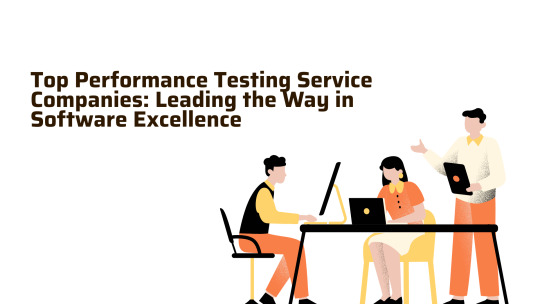
In today’s fast-paced digital environment, ensuring that applications and systems perform seamlessly under various workloads is more critical than ever. Performance Testing Services play a pivotal role in achieving this by identifying potential bottlenecks and ensuring optimal system reliability. Businesses rely on expert providers to deliver these solutions, and here’s our curated list of the Top Performance Testing Service Companies to guide you.
1. Vee Technologies
Vee Technologies stands out as the leader among the Performance Testing Service Companies for its unmatched expertise and commitment to delivering top-tier Performance Testing Services. With a comprehensive suite of testing solutions, Vee Technologies ensures your applications are robust, scalable, and ready to handle real-world demands. Their dedicated team uses cutting-edge tools and methodologies to optimize application performance, making them the go-to choice for enterprises worldwide.
2. Accenture
A global consulting and technology services powerhouse, Accenture is renowned for its expertise in Performance Testing Services. Leveraging advanced automation tools, they help businesses identify and resolve performance issues quickly and efficiently.
3. Infosys
As a trusted IT services provider, Infosys delivers comprehensive Performance Testing Services to ensure seamless user experiences. They specialize in load testing, stress testing, and scalability analysis for businesses across industries.
4. Capgemini
Capgemini is a major player in the IT services domain and excels in offering cutting-edge Performance Testing Services. Their end-to-end testing framework ensures optimal application performance under varying conditions.
5. TCS (Tata Consultancy Services)
TCS is one of the largest IT services companies globally and a leader in Performance Testing Services. Their tailored testing solutions help businesses maintain high system efficiency and user satisfaction.
6. Cognizant
Known for its innovative IT services, Cognizant offers robust Performance Testing Services. They focus on delivering scalable and high-performing applications through thorough testing and analysis.
7. IBM
IBM integrates AI and analytics into its Performance Testing Services to ensure applications meet modern demands. Their solutions emphasize reducing downtime and optimizing performance.
8. Wipro
Wipro is a global leader in IT services and provides reliable Performance Testing Services. Their specialized testing solutions focus on scalability, reliability, and faster time-to-market.
9. DXC Technology
DXC Technology is a strong contender among the Top Performance Testing Service Companies, delivering advanced Performance Testing Services. They cater to enterprises needing high-quality performance analysis and optimization.
10. Tech Mahindra
With a customer-centric approach, Tech Mahindra offers exceptional Performance Testing Services tailored to diverse business needs. Their expertise lies in minimizing application downtime and ensuring seamless scalability.
Why Performance Testing Services Are Vital
Performance Testing Services help organizations detect potential issues early, ensuring that applications function effectively under different user loads. Partnering with one of the 10 Best Performance Testing Service Provider Companies can help businesses maintain high performance and provide superior user experiences.
Conclusion
Selecting the right partner from the Top Performance Testing Service Companies is crucial to your business’s success. With Vee Technologies leading the pack, businesses can rely on cutting-edge solutions tailored to their unique needs. Explore these companies to find the right Performance Testing Services provider that ensures your applications are always at their best.
#PerformanceTesting#LoadTesting#SoftwareTesting#QualityAssurance#PerformanceOptimization#WebPerformance#ITServices#TechSolutions
0 notes
Link
American Airlines planes sit by their gates at the Miami International Airport on October 25, 2024 in Miami, Florida.Joe Raedle | Getty ImagesAmerican Airlines briefly grounded its U.S. flights Tuesday morning due to a technical problem, snarling travel during what carriers expect to be a period of record demand for the holidays.By 7:55 a.m. ET, the ground stop had been lifted, an American Airlines spokeswoman told CNBC. The ground stop lasted for less than an hour.The problem was a network hardware issue involving a platform using DXC Technology, a vendor that maintains the flight operating system that lets flights leave the gate, American said in a statement.The system is tied to critical data like an aircraft's weight and balance, which is required before a flight can leave the gate."That issue has been resolved and flights have resumed," the carrier said in a statement. "We sincerely apologize to our customers for the inconvenience this morning."The Federal Aviation Administration said American had requested the ground stop.Airlines routinely request ground stops, which hold flights at origin, so that destination airports aren't overwhelmed by flights with nowhere to park when there are disruptions. In addition to technical problems, ground stops are put in place for thunderstorms and other severe weather.American was operating a smaller schedule on Christmas Eve compared with other days around the Christmas holiday. The carrier didn't have any cancellations tied to the issue, a spokeswoman said.Airlines' patchwork systems of critical technology platforms have gained more attention lately after periods of mass flight cancellations such as Southwest's meltdown during the 2022 year-end holiday season and Delta's struggle to recover from the CrowdStrike outage this past summer.Correction: The ground stop was issued Tuesday. An earlier version misstated the timing.Don’t miss these insights from CNBC PRO atOptions = 'key' : '6c396458fda3ada2fbfcbb375349ce34', 'format' : 'iframe', 'height' : 60, 'width' : 468, 'params' : ;
0 notes
Text
Top Performance Testing Services Companies: Leading the Way in Software Excellence
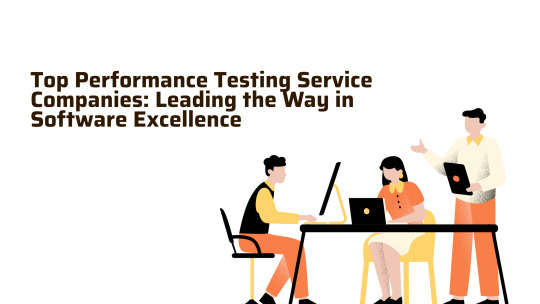
In today’s fast-paced digital environment, ensuring that applications and systems perform seamlessly under various workloads is more critical than ever. Performance Testing Services play a pivotal role in achieving this by identifying potential bottlenecks and ensuring optimal system reliability. Businesses rely on expert providers to deliver these solutions, and here’s our curated list of the Top Performance Testing Service Companies to guide you.
1. Vee Technologies
Vee Technologies stands out as the leader among the Performance Testing Service Companies for its unmatched expertise and commitment to delivering top-tier Performance Testing Services. With a comprehensive suite of testing solutions, Vee Technologies ensures your applications are robust, scalable, and ready to handle real-world demands. Their dedicated team uses cutting-edge tools and methodologies to optimize application performance, making them the go-to choice for enterprises worldwide.
2. Accenture
A global consulting and technology services powerhouse, Accenture is renowned for its expertise in Performance Testing Services. Leveraging advanced automation tools, they help businesses identify and resolve performance issues quickly and efficiently.
3. Infosys
As a trusted IT services provider, Infosys delivers comprehensive Performance Testing Services to ensure seamless user experiences. They specialize in load testing, stress testing, and scalability analysis for businesses across industries.
4. Capgemini
Capgemini is a major player in the IT services domain and excels in offering cutting-edge Performance Testing Services. Their end-to-end testing framework ensures optimal application performance under varying conditions.
5. TCS (Tata Consultancy Services)
TCS is one of the largest IT services companies globally and a leader in Performance Testing Services. Their tailored testing solutions help businesses maintain high system efficiency and user satisfaction.
6. Cognizant
Known for its innovative IT services, Cognizant offers robust Performance Testing Services. They focus on delivering scalable and high-performing applications through thorough testing and analysis.
7. IBM
IBM integrates AI and analytics into its Performance Testing Services to ensure applications meet modern demands. Their solutions emphasize reducing downtime and optimizing performance.
8. Wipro
Wipro is a global leader in IT services and provides reliable Performance Testing Services. Their specialized testing solutions focus on scalability, reliability, and faster time-to-market.
9. DXC Technology
DXC Technology is a strong contender among the Top Performance Testing Service Companies, delivering advanced Performance Testing Services. They cater to enterprises needing high-quality performance analysis and optimization.
10. Tech Mahindra
With a customer-centric approach, Tech Mahindra offers exceptional Performance Testing Services tailored to diverse business needs. Their expertise lies in minimizing application downtime and ensuring seamless scalability.
Why Performance Testing Services Are Vital
Performance Testing Services help organizations detect potential issues early, ensuring that applications function effectively under different user loads. Partnering with one of the 10 Best Performance Testing Service Provider Companies can help businesses maintain high performance and provide superior user experiences.
Conclusion
Selecting the right partner from the Top Performance Testing Service Companies is crucial to your business’s success. With Vee Technologies leading the pack, businesses can rely on cutting-edge solutions tailored to their unique needs. Explore these companies to find the right Performance Testing Services provider that ensures your applications are always at their best.
#PerformanceTesting#LoadTesting#SoftwareTesting#QualityAssurance#PerformanceOptimization#WebPerformance#ITServices#TechSolutions
0 notes
Text
Managed Services Market
Managed Services Market Size, Share, Trends: IBM Corporation Leads
Rising adoption of AI and automation in managed services
Market Overview:
The Managed Services Market is projected to grow at a CAGR of 9.1% from 2024 to 2031. The market size is expected to increase from USD XX in 2024 to USD YY by 2031.
North America currently dominates the market, driven by the high adoption of advanced technologies and the presence of major managed service providers. Key metrics include the number of managed service contracts, average contract value, and customer retention rates.
The market is expanding rapidly because of the increasing complexity of IT infrastructure, increased cybersecurity concerns, and a growing demand for cost-effective IT solutions. The COVID-19 pandemic has intensified the demand for flexible and scalable managed services to serve remote work environments and digital transformation activities.
DOWNLOAD FREE SAMPLE
Market Dynamics:
The managed services business is experiencing a tremendous shift towards AI-powered solutions and automation. This trend is motivated by the need for increased efficiency, cost savings, and better service delivery. AI and machine learning technologies are being integrated into managed service offerings, allowing for predictive maintenance, automated incident resolution, and intelligent resource allocation.
Market Segmentation:
Managed cloud services dominate the managed services market, accounting for approximately YY% of the total market share. This dominance is ascribed to the growing usage of cloud computing in a variety of industries, as well as the complexity of administering hybrid and multicloud settings.
Market Key Players:
IBM Corporation
Accenture plc
Cognizant Technology Solutions Corporation
DXC Technology Company
Fujitsu Limited
Atos SE
Contact Us:
Name: Hari Krishna
Email us: [email protected]
Website: https://aurorawaveintellects.com/
0 notes